Documenting client sessions effectively is critical but often inefficient. Many therapists, psychologists, and clinic owners waste precious clinical hours on documentation only to end up with notes that are unclear, inconsistent, or even non-compliant.
Mastering the BIRP format for behavioural health professionals transforms this essential task:
- Save time with a clear, repeatable structure.
- Improve client care through better progress tracking.
- Reduce errors with standardised, compliant notes.
- Boost engagement by keeping sessions goal-oriented.
Follow our practical steps to write effective BIRP notes faster than ever, avoid common documentation traps, and discover how pre-built Medesk templates can automate the bulk of the work.
Learn how to simplify your practice workflow and free up more time for patients with Medesk.
Open the detailed description >>What are BIRP Notes?
BIRP is an acronym that breaks each session into four key components:
- Behaviour. What you observed (actions, speech, emotions).
- Intervention. What you did (techniques, homework, guidance).
- Response. How the client reacted (verbal and non-verbal).
- Plan. Next steps (for both client and clinician).
Think of them as the story of your session told in four clear chapters: what you observed, what you did, how the client reacted, and what happens next.
This note format creates clarity and focus. You’re not left guessing what to write, and colleagues reviewing the clinical notes can follow the logic easily. It’s also efficient: the standardised format means you spend less time writing and more time with clients. Perhaps most importantly, it supports better outcomes because it makes trends and changes more visible and supports continuity of care.
BIRP notes also offer peace of mind. In behavioural health, the documentation process is all about compliance. Regulatory bodies and legal processes expect clear, objective records. Using a structured method reduces risk.
Of course, BIRP isn’t the only framework out there. SOAP notes (Subjective, Objective, Assessment, Plan) are widely used in general medicine, while DAP notes (Data, Assessment, Plan) are a simplified alternative. But for counselling, psychology, coaching, and psychiatry, BIRP has the edge because:
- It focuses on observable behaviour rather than subjective interpretation.
- It directly links interventions to client responses, making progress clearer.
DAP vs. SOAP vs. BIRP: What’s the Difference?
| Feature | DAP Notes | SOAP Notes | BIRP Notes |
|---|---|---|---|
| Acronym Meaning | Data, Assessment, Plan | Subjective, Objective, Assessment, Plan | Behavior, Intervention, Response, Plan |
| Main Focus | Balances objectivity with clinical judgment | Separates subjective client input from objective observations | Highlights interventions and client response during session |
| Best For | Mental health, social work, counseling where concise, holistic notes are needed | Medical and allied health fields; multidisciplinary teams | Behavioral health, addiction counseling, and progress tracking |
| Strengths | Easy to learn, quick to write, integrates observation and analysis naturally | Clear separation of facts and feelings, highly structured | Focus on treatment methods and immediate effects |
| Limitations | Less separation between subjective and objective data than SOAP | Can feel rigid and time-consuming | May omit broader context if over-focused on interventions |
| Common Use Cases | Therapy sessions, school counseling, case management | Primary care, psychiatry, multidisciplinary case notes | Substance abuse programs, behavior therapy |
How to Write BIRP Notes Sections
Now we will look at each section separately, giving examples of effective and poor writing styles so that you can take a ready-made BIRP note template and use it as a cheat sheet in your own practice. Let's start with section B.
Medesk helps automate scheduling and record-keeping, allowing you to recreate an individual approach to each patient, providing them with maximum attention.
Learn more >>B is for Behaviour: capture what you observed
The first step is about what you saw and heard. This isn’t the place for guesses or interpretations; it’s about observable facts. For example, instead of writing “client appeared anxious”, you might write “client presented and tapped foot rapidly throughout session and avoided eye contact.” Notice how the second version is specific, measurable, and leaves no room for misinterpretation.
It also helps to add context where relevant. If you noticed the behaviour increased when a certain topic was raised, note it. This makes the record far more useful for tracking triggers over time.
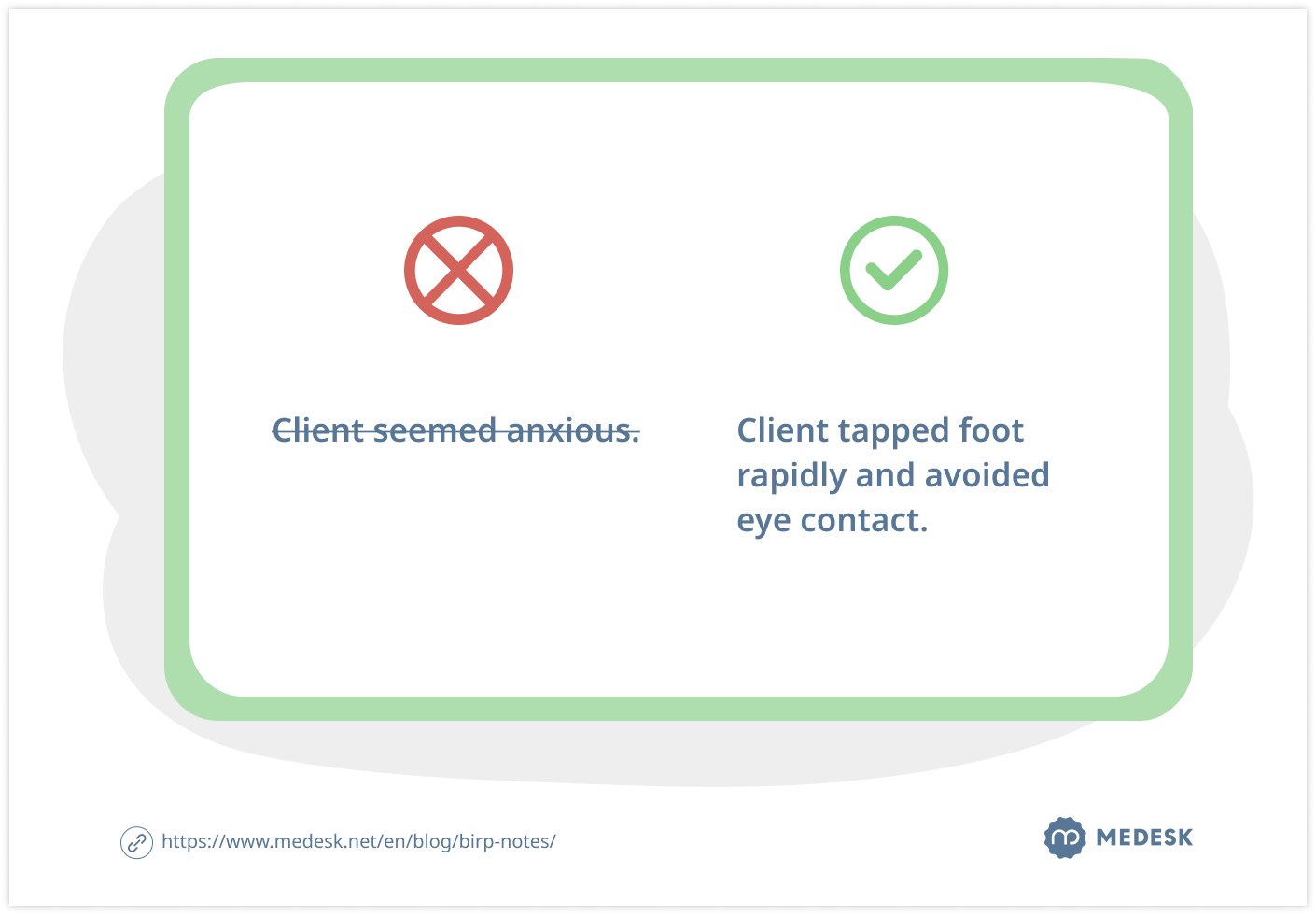
A common mistake here is vagueness. Words like “down”, “angry”, or “resistant” tell very little. Try instead: “The client spoke in a monotone, and reported sleeping 12 hours daily.” Clear, factual detail gives you a better baseline for future sessions.
As soon as the therapy session ends, write down two or three key observable client’s behaviors. It’s much easier than trying to recall them later.
I is for Intervention: document your actions
Next, record what you did in response. Again, clarity is everything. Write in plain language what techniques or strategies you used. For example: “explored client’s thought ‘I am a failure’ using CBT techniques” or “homework assignment: mood tracking journal for seven days.”
The intervention section should link back to the client’s treatment plan. If the overall goal is reducing anxiety, show how your action supported that. You don’t need to catalogue every small detail of your therapeutic style, just the meaningful specific interventions.
One common pitfall is overcomplicating the language. Instead of “utilised a multi-modal psychodynamic and humanistic approach”, simply say, “explored client’s early relationship patterns and how these relate to current stressors”. It’s clear, accessible, and useful.
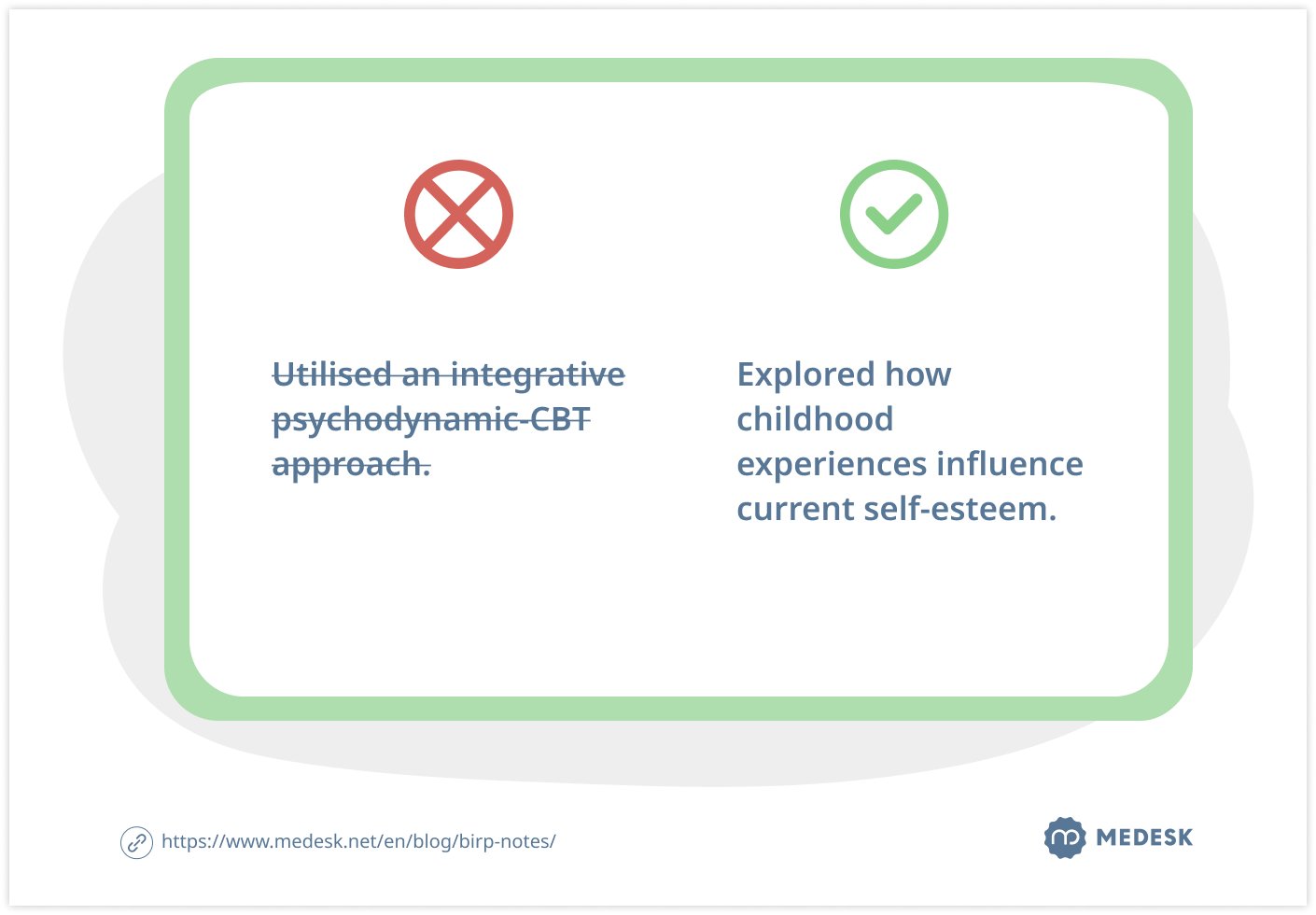
Imagine another clinician reading your note. Would they understand what you did and why in under 30 seconds? If yes, you’ve nailed it.
Discover more about the essential features of Medesk and claim your free access today!
Explore now >>R is for Response: record the client’s reaction
Here, you capture how the client responded. This is where you can include short quotes, body language, or changes in mood. “Client reported, ‘I see how that thought isn’t true,’” tells you much more than “client understood.”
Don’t forget non-verbal cues. Did the client smile, relax in posture, or become tearful? These details matter, especially when tracking client progress session to session.
The mistake many people make is to drift into interpretation. Writing “client was resistant” isn’t objective. Better: “client sighed and said, ‘I don’t see the point of doing that homework.’” Keep description and interpretation separate, because your assessment will naturally inform the plan section.
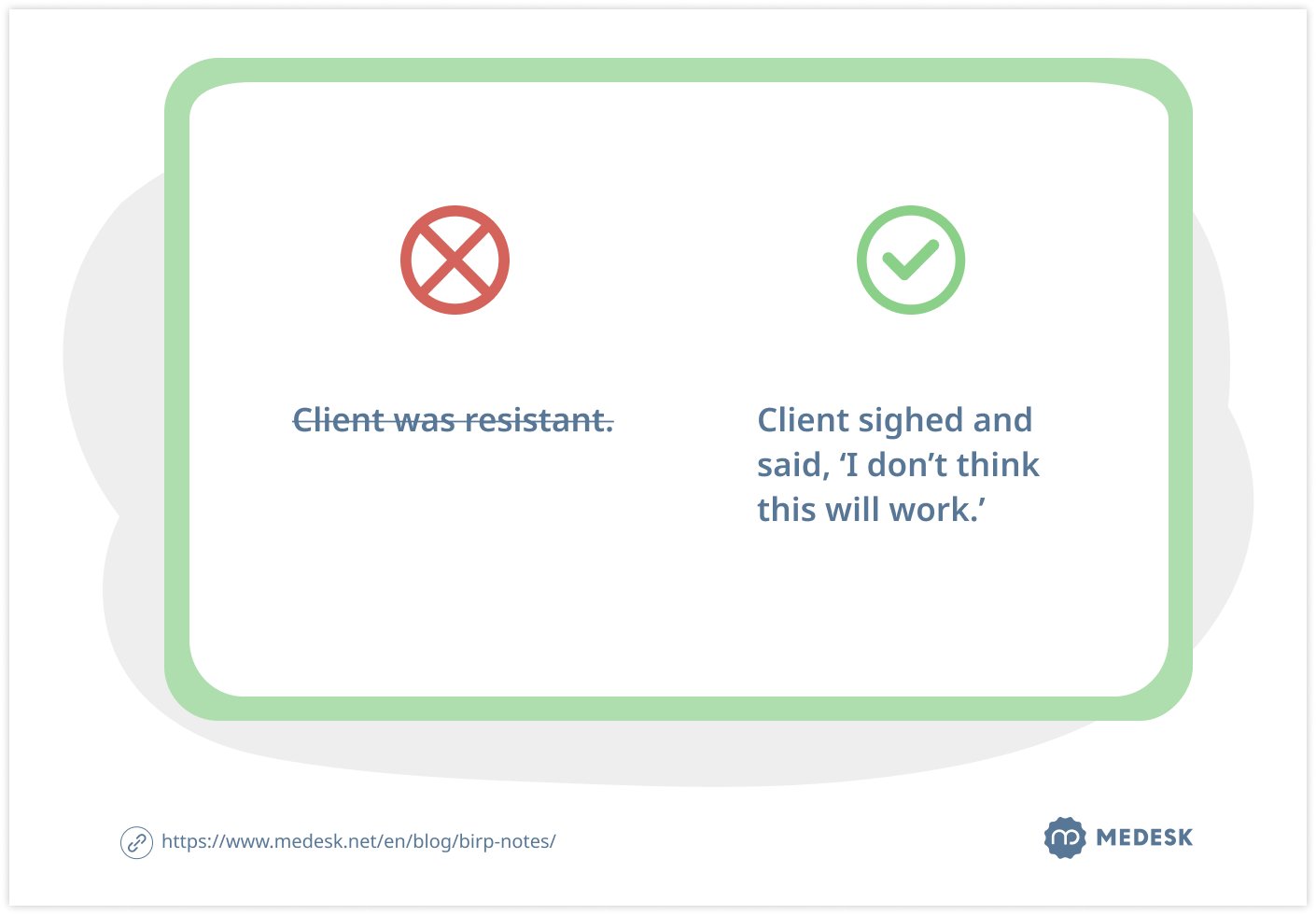
Note at least one direct quote if possible. It brings the client’s voice into the record and shows thought patterns.
P is for Plan: outline the path towards treatment goals
Finally, your plan sets the direction. The plan section of the BIRP note format must always be concrete and specific. “Continue working on anxiety” is vague. A stronger entry might be: “Client to practise deep breathing technique twice daily; therapist to source relaxation script for next session; next appointment on 10th September to begin anxiety hierarchy development.”
Timeframes and follow-up actions make the plan more powerful. Specify both what the client will do and what you will do. This shows accountability on both sides.
Too often, clinicians either skip this section or keep it too general. Remember, this is the bridge between sessions. Without it, progress stalls.
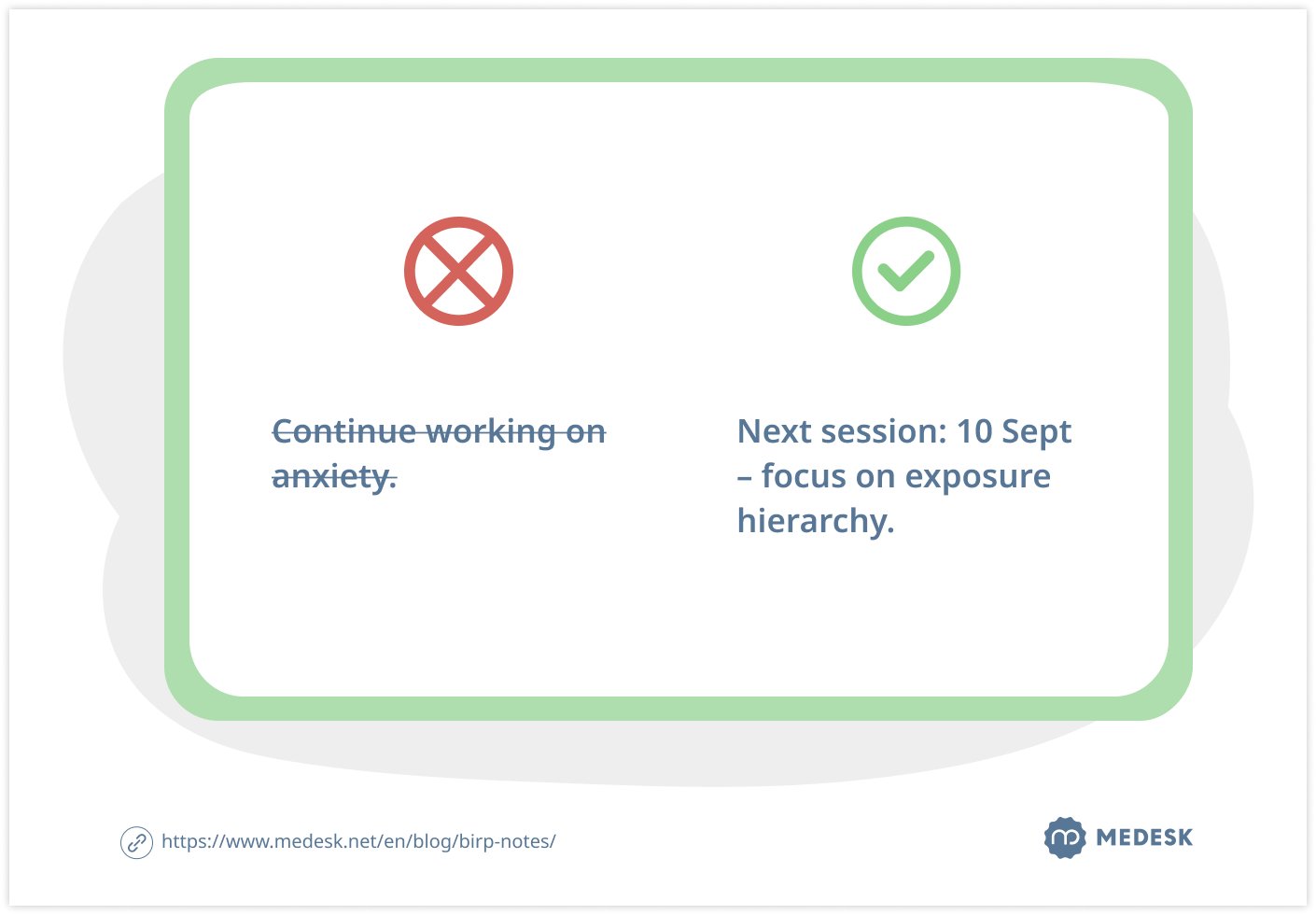
Always end your note with at least one client action and one clinician action. It keeps momentum alive.
Common BIRP Notes Mistakes and How to Avoid Them
We have already reviewed the errors typical for each section of BIRP notes. For greater convenience, keep a table of the main ones: save it for yourself or send it to your colleagues.
| Common Mistake | Why It’s a Problem | Quick Fix |
|---|---|---|
| Writing a novel (too long & unfocused) | Overly detailed notes waste time and bury the important points. | Be concise. Stick to relevant facts and key observations. Aim for clarity over volume. |
| Using jargon or overly clinical language | Colleagues (or even clients) may not understand; records can feel inaccessible. | Write in plain English. If technical terms are unavoidable, explain them briefly. |
| Delaying note writing | Memory fades quickly, leading to vague or inaccurate records. | Complete notes as soon as possible, ideally within 24 hours. Use quick templates or voice-to-text tools to capture details. |
| Lack of objectivity (bias creeping in) | Subjective statements weaken accuracy and can cause compliance issues. | Ask: “Is this an observable fact or my interpretation?” Record facts in Behaviour and Response; save analysis for later. |
| Inconsistent formatting | Makes it harder to track progress across sessions; looks unprofessional. | Use the same template every time. Automated EHR templates ensure consistent, structured notes. |
Attentiveness and the use of modern tools for mental health specialists will help to avoid mistakes. While the former may fail under heavy workloads, EHR with built-in templates provides backup at any time.
BIRP Progress Note Example with Medesk Templates
Here’s where technology makes life much easier. Pre-built templates remove the stress of starting from scratch. In Medesk, each section of BIRP is already structured, so you’re guided logically from Behaviour through to Plan.
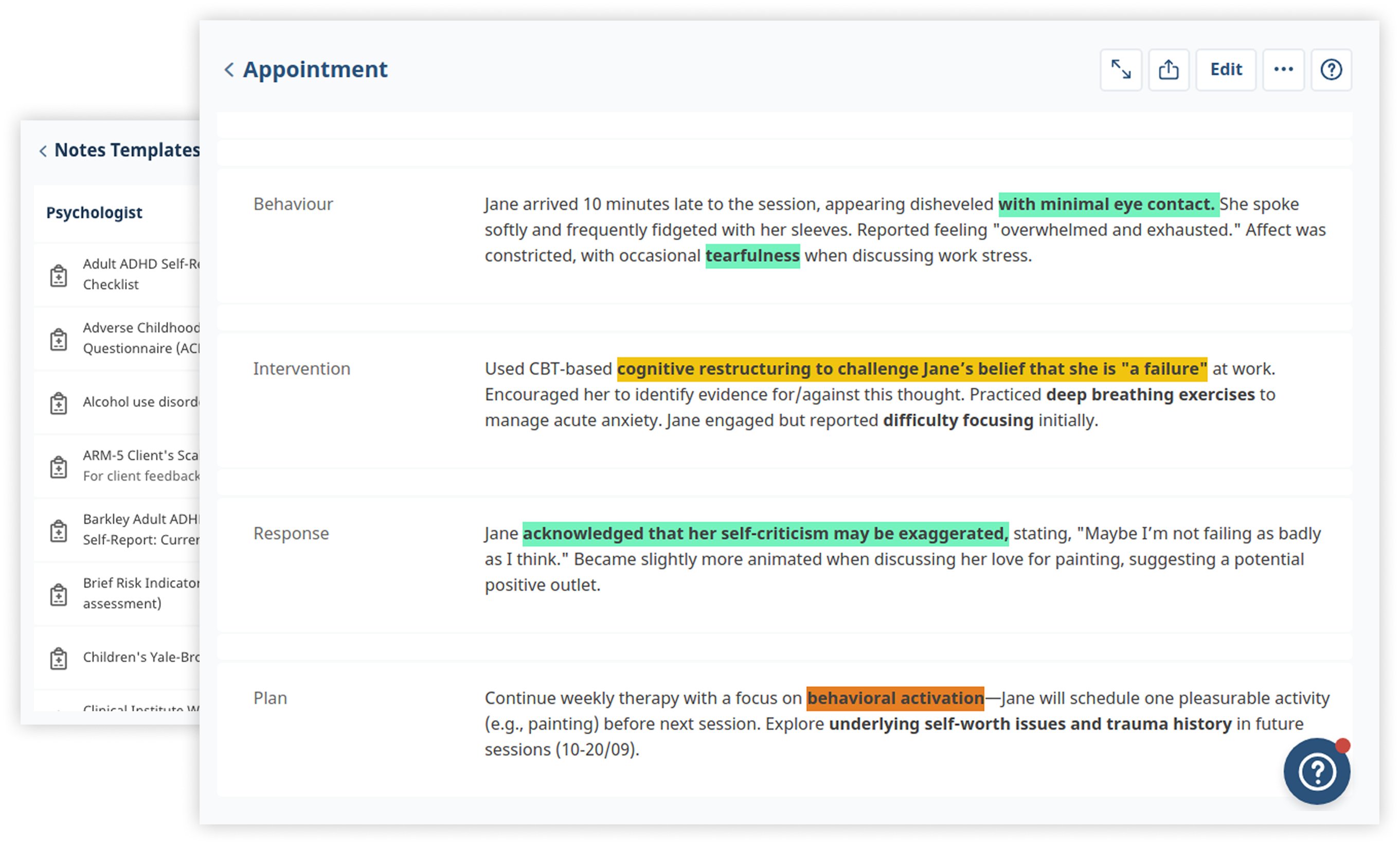
The real power is in customisation. You can adapt templates to your own practice, whether you’re a mental health professional, coach, or behavioral health specialist. Drop-down menus and quick-text options reduce typing dramatically. In fact, many practitioners find they save an average of 5 minutes per note (Medesk internal data). Multiply that by a dozen sessions a week, and the time saved is huge.
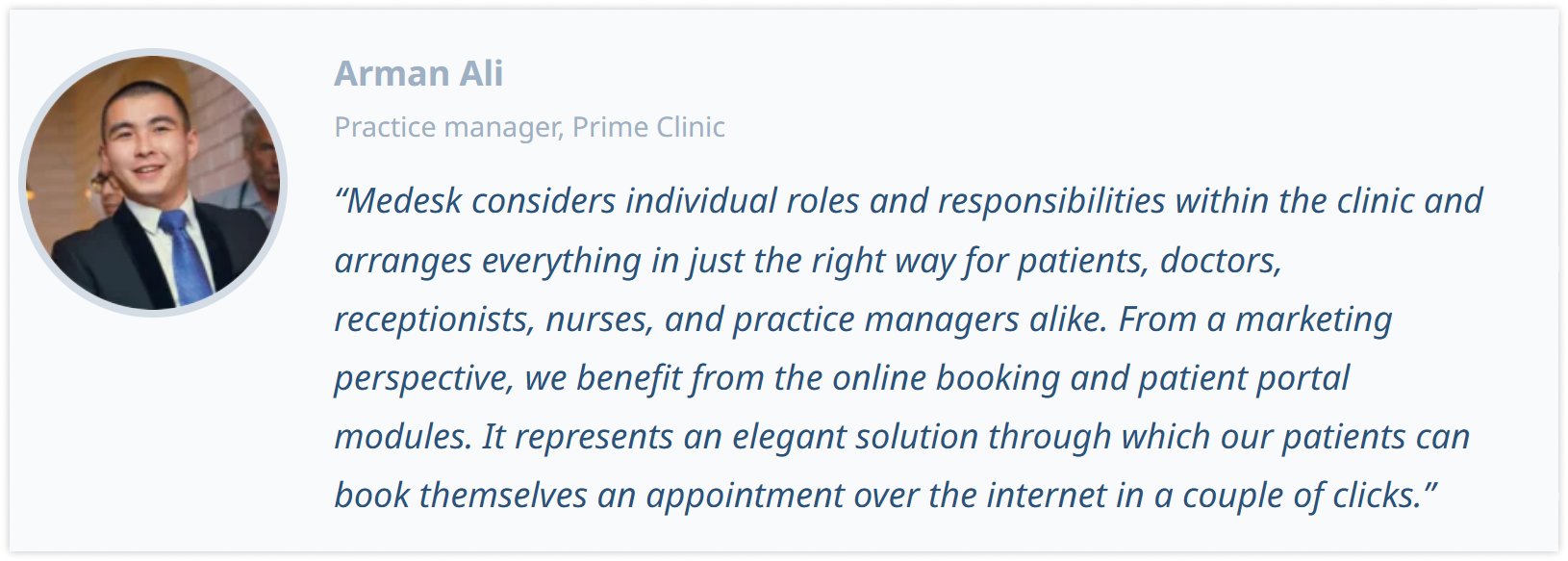
Because Medesk integrates notes into the patient’s electronic record, everything stays secure, organised, and linked to appointments and billing. You don’t just save time; you reduce the chance of mistakes and have peace of mind that records meet compliance standards.
According to the fresh research published in the Journal of Education and Health Promotion, inplementing EHR led to an average time saving of 75 minutes in clinical documentation.
And the best part? Getting started doesn’t require technical expertise. Within a short time, you’ll find note-taking becomes faster, easier, and less stressful—no more late-night catch-up sessions.
BIRP Notes FAQs
→ What are BIRP notes?
BIRP notes are a structured clinical documentation method focusing on Behavior, Intervention, Response, and Plan. It enhances clarity and efficiency in patient care and is often used by healthcare professionals in the mental health sphere.
→ How long should a BIRP note be?
Typically half to one page. Enough to capture essentials, but concise. Templates help you strike the right balance.
→ Can clients access their BIRP notes?
Yes. Under GDPR, patients have a right to access their records. Write notes objectively, knowing they may be read by clients.
→ Do I have to use BIRP?
Not necessarily. SOAP or DAP may work in some contexts. But for behavioural health, BIRP is often the most effective. The key is consistency across your practice.
→ How do templates really save time?
They remove repetitive typing, provide ready-made structure, and offer quick-select options. Minutes saved on each note add up fast.
→ Is digital note-taking secure?
More secure than paper. Systems like Medesk use encryption, access controls, and audit trails to protect data far beyond what a locked filing cabinet can achieve.
→ Is switching to a system like Medesk complicated?
Not at all. Medesk is designed to be user-friendly. Many practices transition with minimal disruption and quickly wonder how they managed without it.


